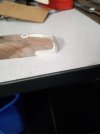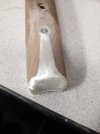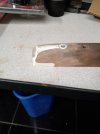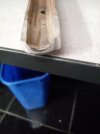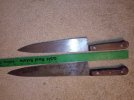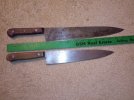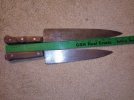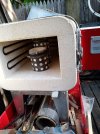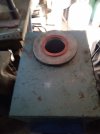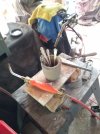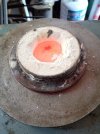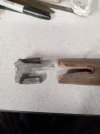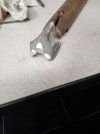Stacy E. Apelt - Bladesmith
ilmarinen - MODERATOR
Moderator
Knifemaker / Craftsman / Service Provider
- Joined
- Aug 20, 2004
- Messages
- 38,176
I haven't been able to get in the shop much for a while due to many things way too long to go into.
I did get a chance to do some casting for the store and a fun project for a friend. He has an 1877 Sharps 45/90 that he is rebuilding. The stock is mainly what is being replaced. He said he wanted a silver fore-stock cap like the one Quigley had Down Under. So I carved out the fore-stock, carved a wax to fit the cut-out, and cast a sterling cap. Then I designed a mounting system to lock it in place. Looking pretty good so far. I still have to fit it to the barrel.
The nice surprise came today when I was delivering some food to a charity that helps feed the migrant workers on the Eastern Shore. The lady saw my knifemaker shirt and asked me if I could safely dispose of some knives for her. She brought me two big chefs knives. that looked well used and heavily patinaed. I asked why she wanted them disposed of and she said they were found in an old building being demolished on a farm and was worried that someone would get hurt by them if they went in the rubble being carted away. I took them and when I got home realized they were 1950-1960 Lamson & Goodnow knives. The set is probably worth $200-300, easy. I called her and told her and she said for me to keep them as a thank-you for helping the feed the farm workers. I plan on dropping off 50 cases of bottled water next week. I'll clean them up just enough and give the handles some oil.
First - The Fore-stock:
I did get a chance to do some casting for the store and a fun project for a friend. He has an 1877 Sharps 45/90 that he is rebuilding. The stock is mainly what is being replaced. He said he wanted a silver fore-stock cap like the one Quigley had Down Under. So I carved out the fore-stock, carved a wax to fit the cut-out, and cast a sterling cap. Then I designed a mounting system to lock it in place. Looking pretty good so far. I still have to fit it to the barrel.
The nice surprise came today when I was delivering some food to a charity that helps feed the migrant workers on the Eastern Shore. The lady saw my knifemaker shirt and asked me if I could safely dispose of some knives for her. She brought me two big chefs knives. that looked well used and heavily patinaed. I asked why she wanted them disposed of and she said they were found in an old building being demolished on a farm and was worried that someone would get hurt by them if they went in the rubble being carted away. I took them and when I got home realized they were 1950-1960 Lamson & Goodnow knives. The set is probably worth $200-300, easy. I called her and told her and she said for me to keep them as a thank-you for helping the feed the farm workers. I plan on dropping off 50 cases of bottled water next week. I'll clean them up just enough and give the handles some oil.
First - The Fore-stock:
Attachments
Last edited:

